Dear creative friends,
Welcome to Issue No. 71 of the Studioworks Journal! I’m so excited to have you join me as we explore the gentle, nurturing concept of wintering—the quiet, reflective season where we embrace stillness, rest, and renewal. As the world outside slows down and the days grow shorter, we, too, can find solace in the art of creating slowly and mindfully.
In this issue, we’ll immerse ourselves in the world of fiber arts—embroidery, knitting, quilting, and more—crafts that connect us to a long tradition of handmade warmth. These tactile forms of creativity invite us to sit with the rhythm of the needle and thread, to appreciate the meditative process of stitching, and to weave our stories into the fabric of our work.
Wintering offers a beautiful parallel to these time-honored practices, encouraging us to cherish the quiet moments of solitude and introspection as we create. How can we honor the stillness within, the soft, cozy textures of winter, and the deep sense of comfort that these art forms bring?
Let’s embrace the slow art of wintering together and find beauty in the quiet, steady work of our hands.
xo,

So you may be wondering, where do I start? To that, I say, wherever feels right to you. Each month we will have a theme, a creative affirmation, a power word, a color palette, sketchbook exercises, art projects, articles, recommended reading, and access to wonderful inspiration and resources. I want you to think of this as a delicious new magazine, you know the ones you occasionally splurge on, with soft, velvety pages, beautiful images, and inspiring content!
Each issue will invite you to explore your creative practice in whichever way works for you. Experience each issue at your own pace. Take what resonates with you and put the rest aside for another time.
Grab a cup of something lovely and dive in.
Winter is a time of reflection that beckons us towards peaceful pursuits. The heavy cloak of long nights urges us inside and reminds us to slow down. With much of the world in a dormant state, it can feel like any activity is asking too much. That’s when it’s time to lean into tasks that are gentle enough to heed the moment's requirements but engaging enough to make the hours fly.
Reflective practices such as knitting, weaving, quilting, and embroidery deftly answer this call. They also bring a needed balance between solitary and communal action. As the history of the quilting bee reveals, coming together as a community to complete a large project accomplishes more than just many hands making light work. It’s an opportunity to learn, teach, share ideas and perspectives, and enrich one another through a collective creative culture.
It’s a powerful way to stave off winter blues, knowing that you are part of a cooperative, even if you spend much of your time alone cozied up under a blanket working on blocks for a quilt top. There’s beauty in solo time spent on a craft that can later be part of a communal project or simply something you share in whatever way suits you. Join me in exploring how to maximize these personal and collective benefits, artfully using textiles to weave your way through winter.
Whether you’re a seasoned embroiderer, knitter, weaver, or quilter or just getting started, you’re ideally situated to use textiles to add texture to your hibernal season. If you haven’t already plied one of these crafts, select one that has always appealed to you. If nothing springs immediately to mind, do a web search and draw up images. Whatever pops, is the one you should choose. Still not convinced? Get out there and visit some stores or a friend you know is a repository of crafting supplies. There’s nothing like actually seeing and touching fabrics, threads, or yarns to get your imagination jumping.
Once you’ve honed in on the chosen one, look into organizations devoted to your textile, locally or online. These will be treasure troves of ideas, support, and fun. Once your calendar is full of dates with your new besties, it’s time to build your snuggle bubble. Gather things that scream hygge (that beautiful Danish word for contentment and coziness) and create a space you don’t want to leave. You can naturally have more than one, but it should ideally be a spot where you can be comfortable, focus, and have your necessary accouterment out and ready for action. These could include a comfortable chair, good lighting, a storage system for your materials, and a table or surface for your work.
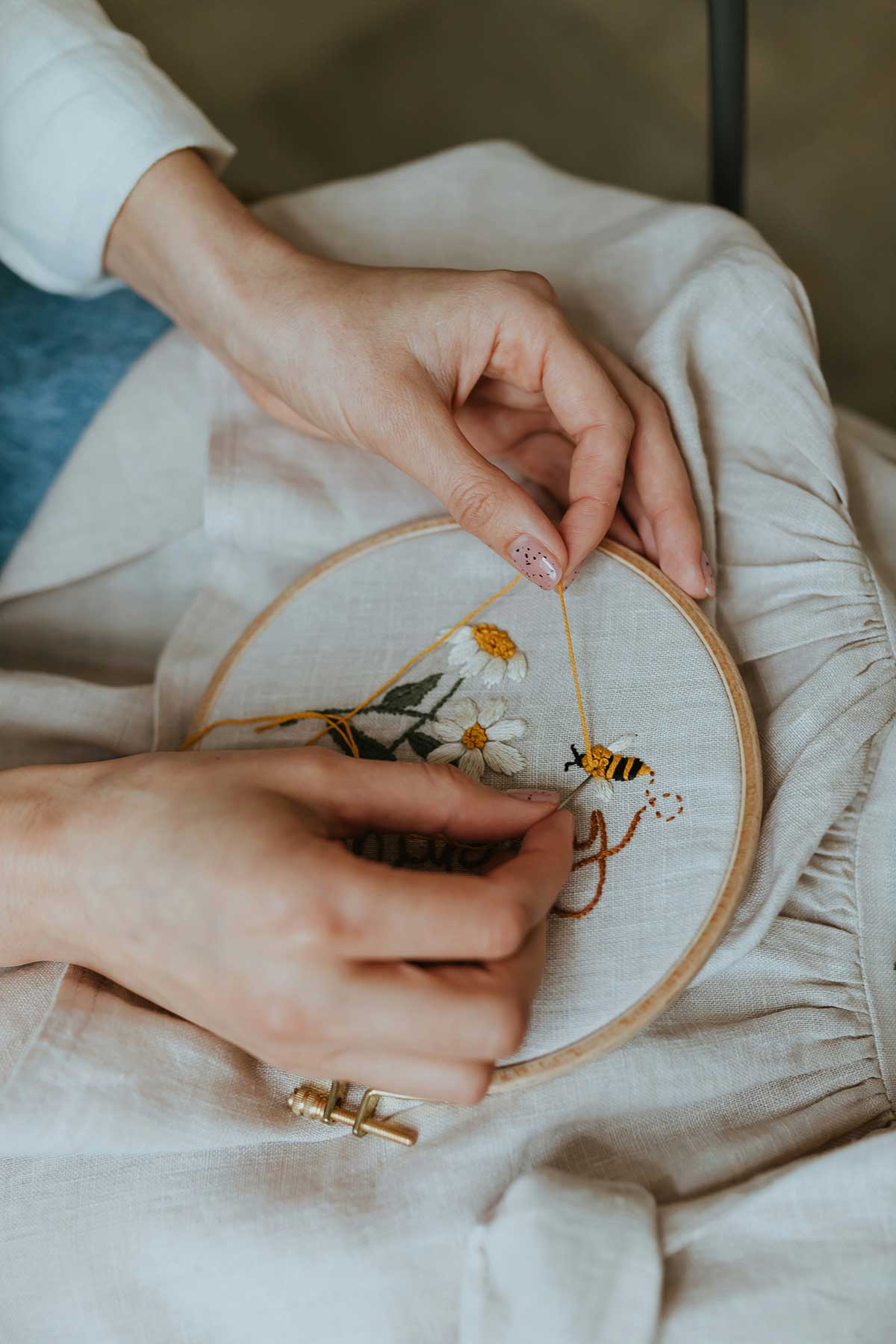
Provisioned with your chosen craft and your hug of a space, decide the direction and scope of the project you want to embark upon. Is it large, as in it might take you all winter (or longer!), or is it small, something to be completed in hours or days? Is it a solo excursion or a block or two for a group quilt? What kind of feeling does it possess? Is it dark-hued and intense, reflecting the brumal world around you, or is it light, bright, and cheerful, bringing a relieving contrast with wintry gloom?
If you’re working alone, examine what you might want to birth during this wintertide. What feelings, emotions, or ideas, big or small, are percolating in you? Feel the nature of your materials and let this tactile experience help to guide you.
If you’re working with a group, collaborate on something that speaks to your collective goals. Do you want to make a statement, commemorate an event, or simply make something beautiful? Again, let the medium you’ve chosen, its physical qualities and textures, help guide your choices.
Remember, whatever direction you choose, flow with the rhythm of the materials. Something completed one stitch at a time has a potency that brings you here, into the moment, and provides a meditation on how anything of value is built in just this way. The more attention and care you bring to your stitches, the more beautiful your piece will be.
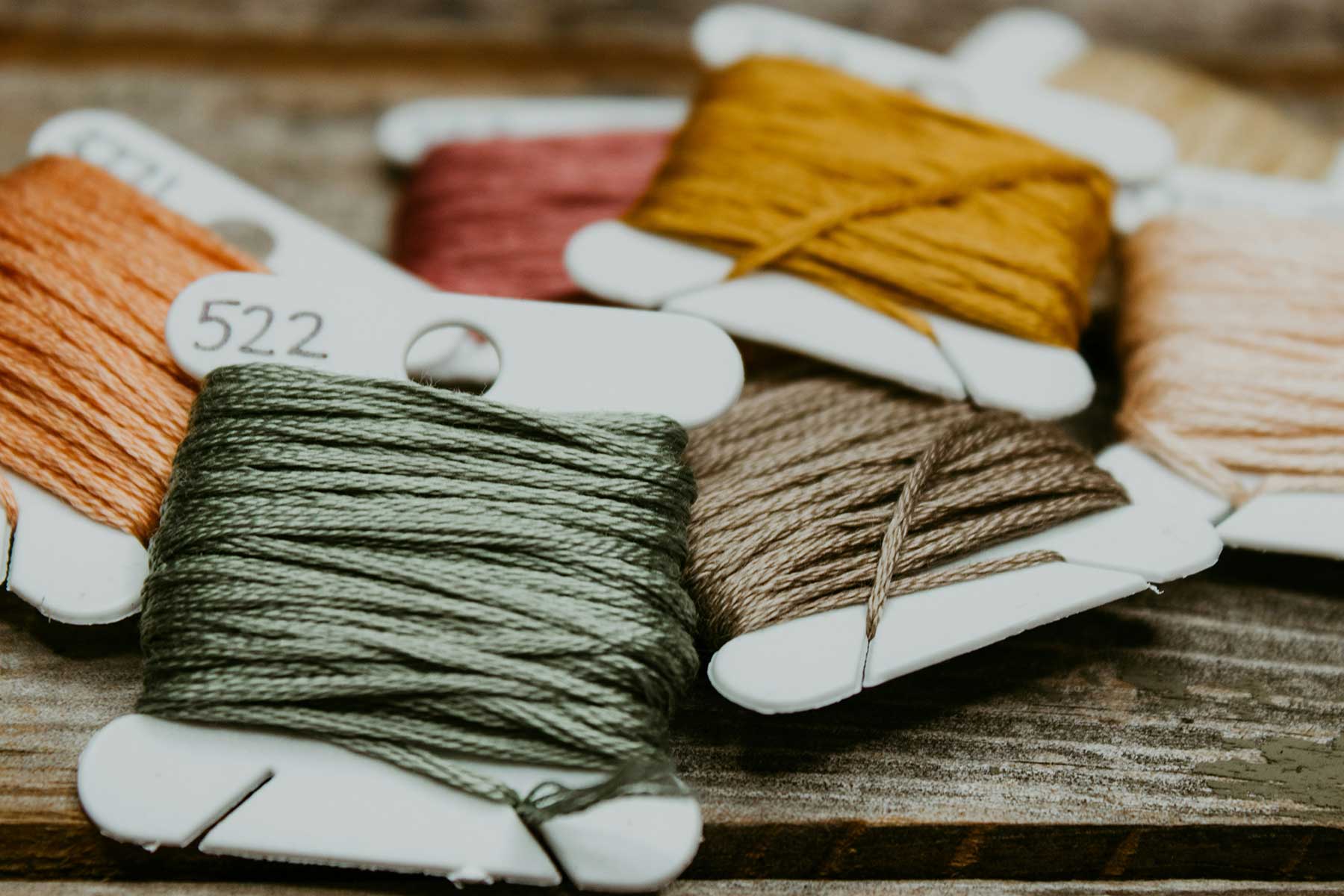
We all recognize the manifold challenges the winter season can flurry in. Fortunately, with a bit of preparation and ingenuity, it can be transmuted into a rich period of creative flow. By selecting projects that naturally tap into the season's strengths, such as reflection, contemplation, and peaceful restorative action, we can make an art of wintering.
Textiles generate the perfect template for mastering stillness and embracing the hibernal. By slowing down to the pace of a stitch, we can mindfully create in ways that nurture, bolster, and feed ourselves and those closest to us. And this, my friends, is what art is truly about.
Few people embark upon the winter months without experiencing some trepidation. The long nights, chilly days, and yawning hours sequestered indoors can challenge the mind, body, and spirit. With this knowledge in mind, many cultures have, since antiquity, fostered traditions that help community members support one another, bringing joy and light to dark days by coming together for a common cause.
A beautiful example of this is the quilting bee. These social affairs combined the practical necessity of making something that provided warmth from the bite of winter with creative expression and group effort. They not only generated an excuse to gather, accomplish a task, and share a little gossip that was universally accepted by society but also played a significant role in preserving cultural heritage. Join me as I stitch together the alluring pattern of quilter influence, highlighting their significance in art, politics, family, and community.
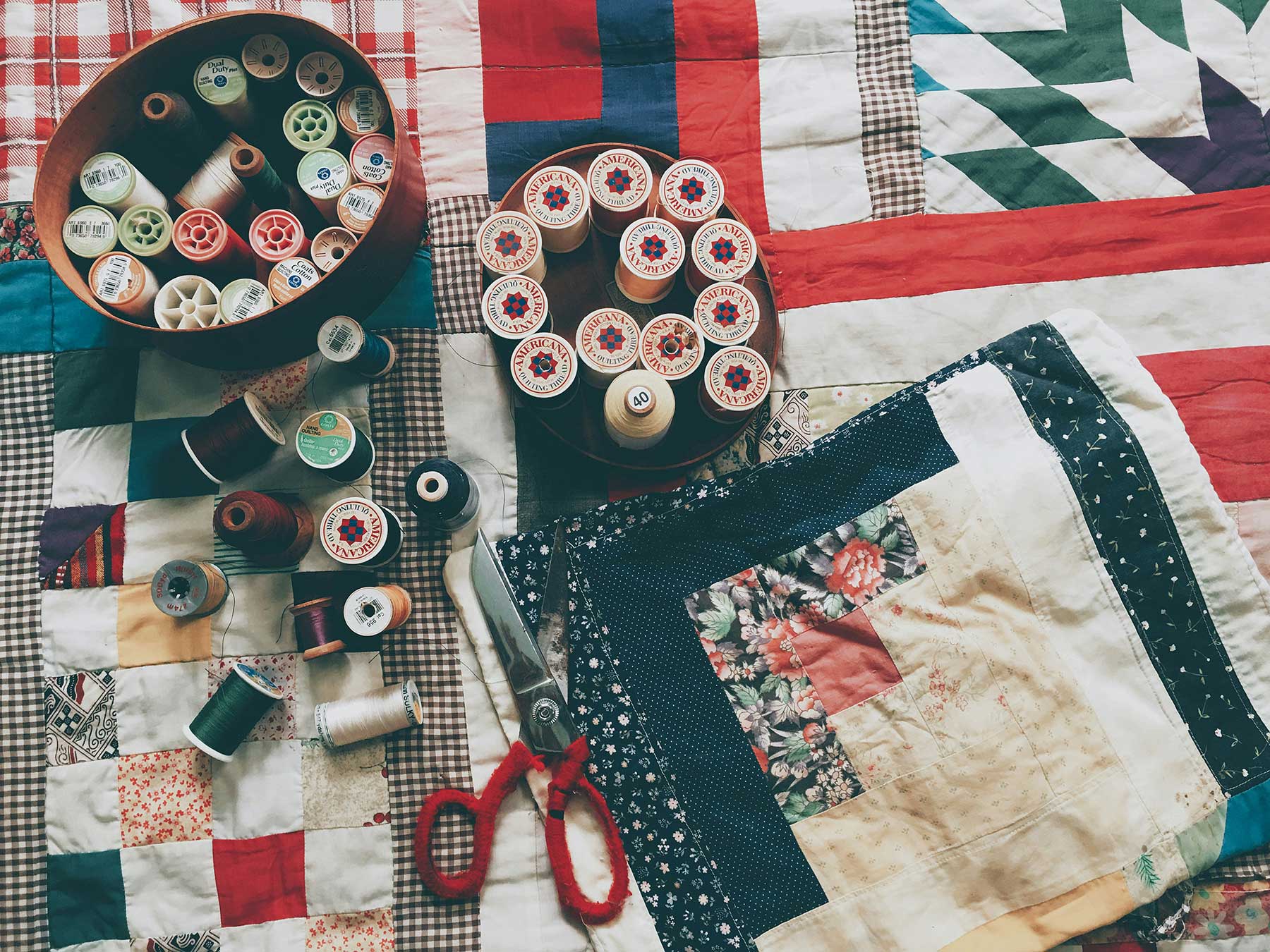
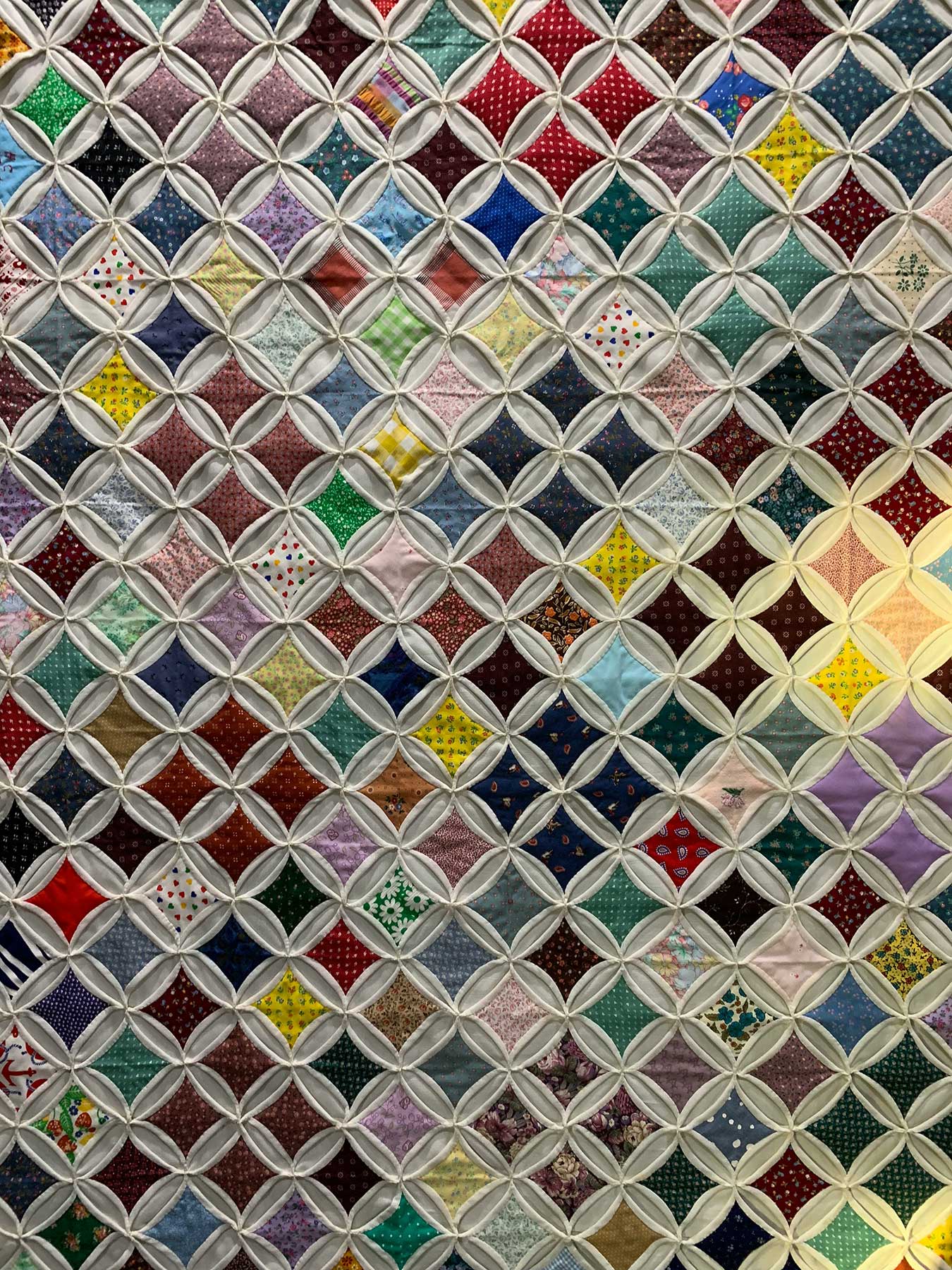
Quilting is not a new craft—the first evidence of stitching together layers of padding and fabric dates back as far as 3400 BCE. Though the primary aim of the process was to provide insulation and warmth, with time and resources, quilting dissolved the line between craft and fine art and, in so doing, elevated traditionally under-appreciated domestic creations to a deservedly honored place.
In Europe, the likely origin of quilting is from the 12th century when crusaders utilized quilted garments as protective underlayments to their heavy armor. Over time, this custom bred the use of doublets, which were snug-fitting jackets initially worn under outer layers but eventually became the defining shape of men’s fashion. Though the point at which quilting became more broadly used is unclear, the oldest existing European decorative piece is the Tristan Quilt from Sicily, dating from around 1360.
By the time Europeans began emigrating to America, quilts had become a valued possession of the wealthy. Wholecloth quilts made of a top, a filling, and a backing with only the stitch as a design feature were luxury imports the average American couldn’t afford. At that time, women made quilts piecemeal from whatever spare materials were available. However, with the Industrial Revolution came greater access to textiles, and by the 1840s, quilting became a widespread practice. It was during this era that the quilting bee rose to prominence.
During the colonial period, any shared communal activity that benefited one’s neighbors became known as a ‘bee.’ This term, believed to derive from the Middle English word ‘bene,’ signifies a boon or prayer. The term was applied across disciplines, so a barn-raising bee would entail the community coming together to raise the walls of a barn and build a roof. Similarly, a logging bee involved collectively felling wood for building or heating homes, and a husking bee was a gathering to strip corn.
Hence, a quilting bee was a gathering to collectively complete a quilt. However, much more was accomplished than that. The bees were an expressive place for women to share openly with one another as they created pieces that were beautiful to adorn wedding beds, commemorative to honor the passing of a loved one, or playful to welcome the birth of a child. Each woman’s stitch was her own, and this unique character of quilting made each piece a treasure.
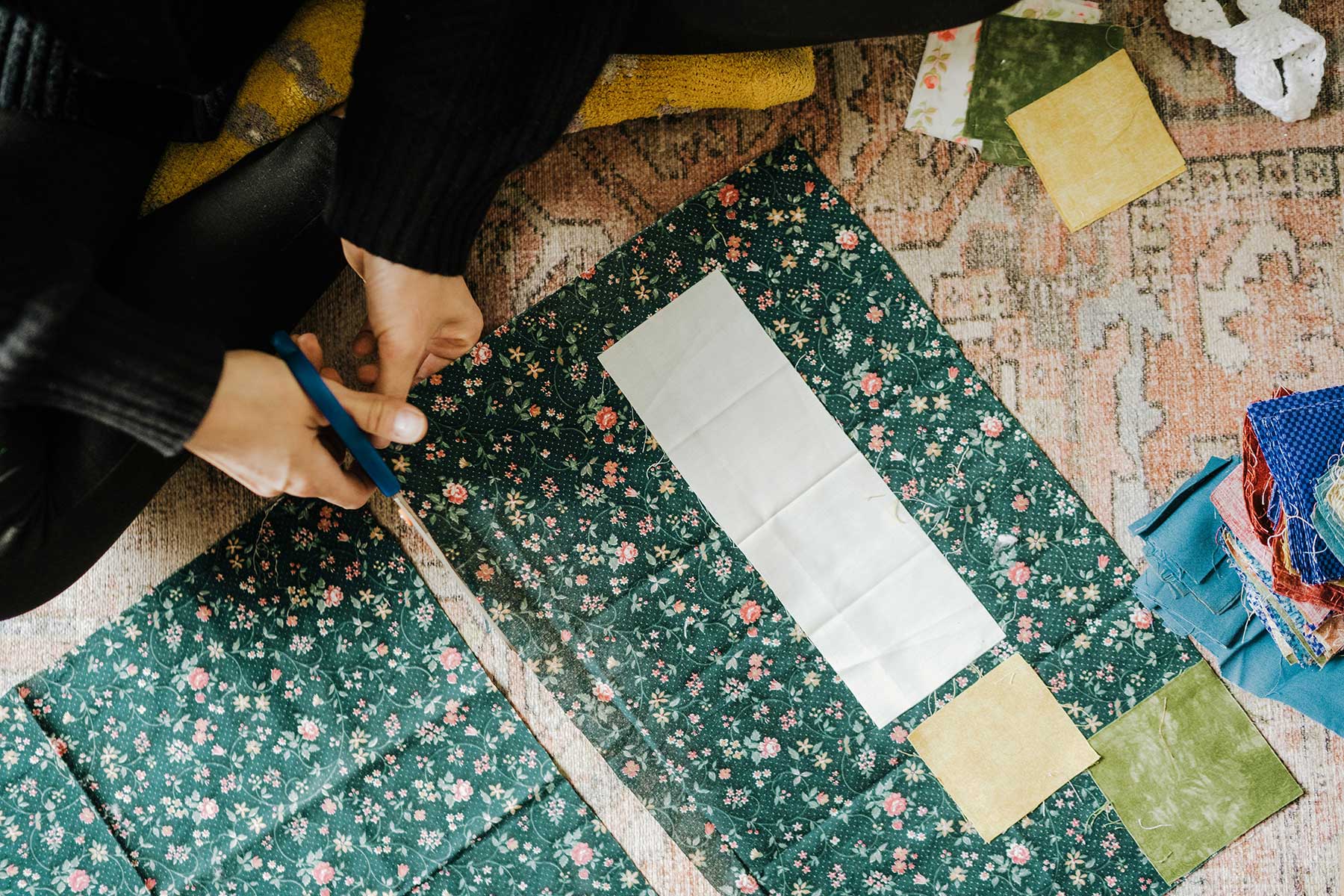
In a time when a woman’s place was thought to be in the home, a venue where she could gather with her peers, talk story, and accomplish a household task was priceless. Quilting bees became a haven for women to express themselves, teach their daughters invaluable skills, swap recipes, exchange home remedies, and oversee courtships. That last was supported by the fact that the end of the quilting often led to sharing food, dancing, and broader communal activities that included everyone—in this way, making the quilts brought as much light and joy to the community as they provided warmth and comfort to the home.
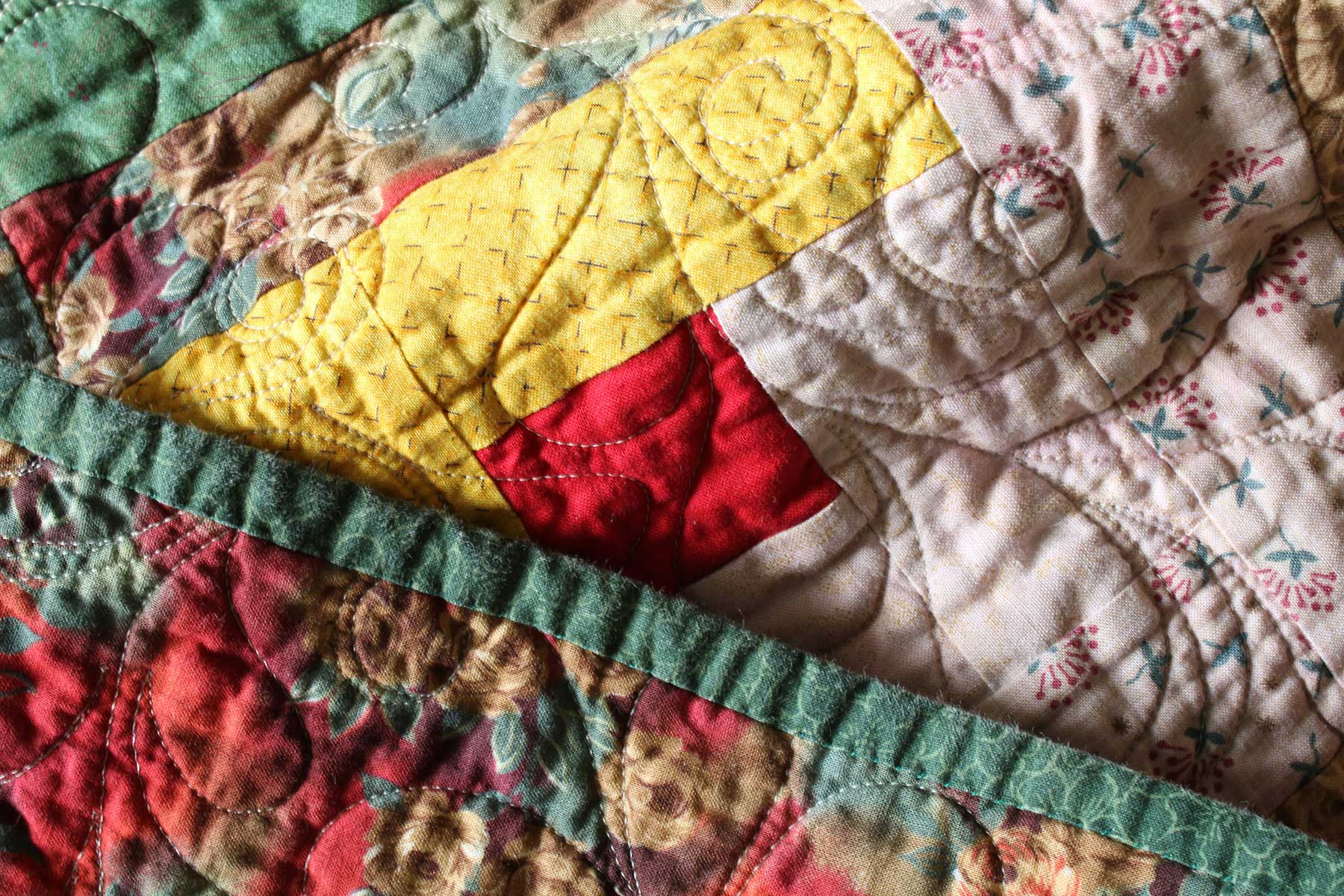
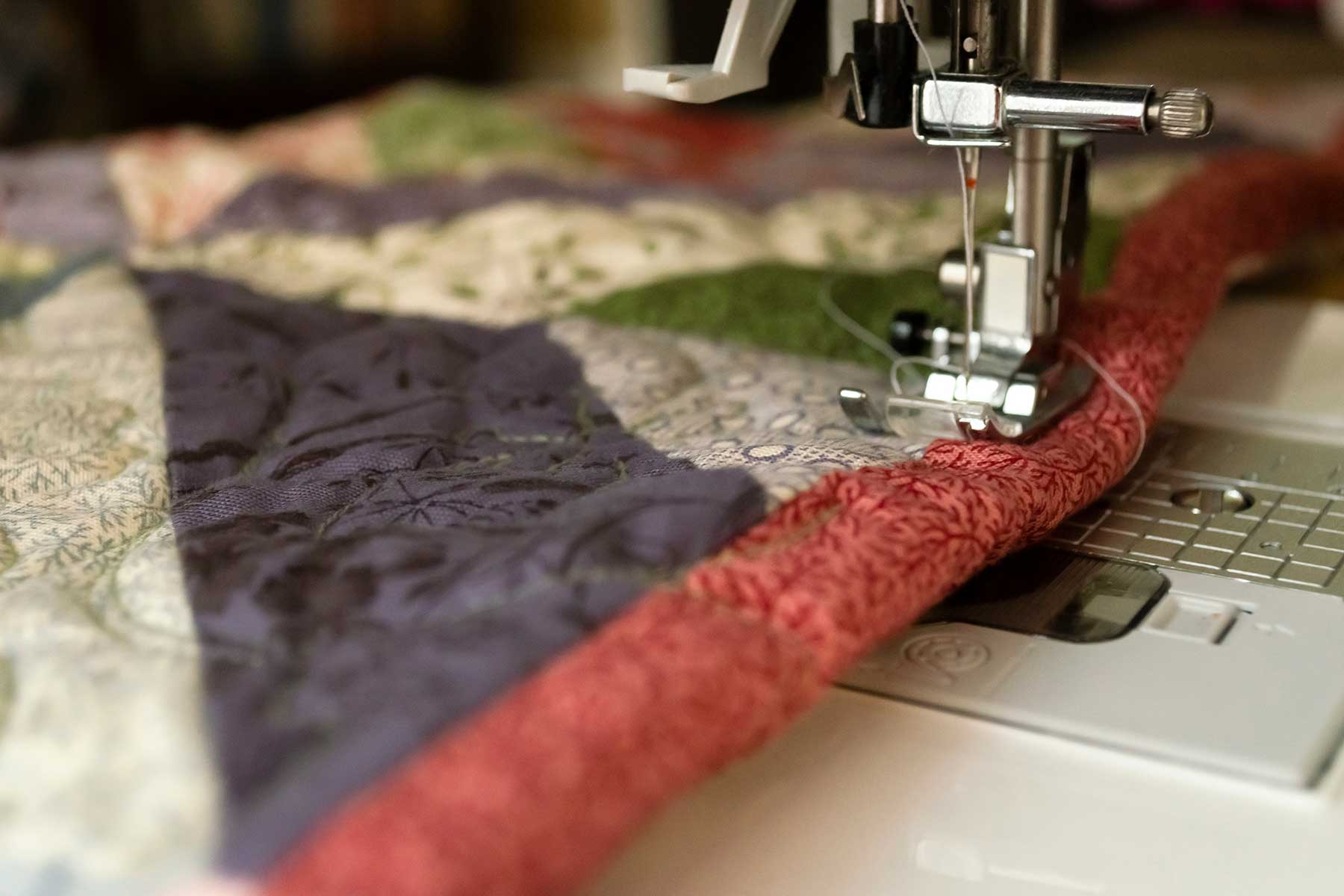
As an accepted place for women to gather, quilting bees unsurprisingly hosted conversations, leading to significant social change. These include everything from Susan B. Anthony forwarding the cause of suffrage to fundraisers for anti-slavery organizations. Folklore has it that quilts hung on laundry lines were used to convey secret messages to guide travelers along the Underground Railroad. Whether that story is true or not, quilts were undoubtedly used for self-expression and commentary by women with few other available outlets.
In modern times, the use of communal quilting projects to convey loss, solidarity, and discontent has taken on monumental proportions. From the Aids Memorial Quilt to the Social Justice Sewing Academy, people everywhere share warmth and creativity as they make quilts for a cause.
For generations, the needle arts of sewing, knitting, lacemaking, embroidery, and quilting were a primary source of female artistic expression. These “Mistress-Pieces,” as some authors have termed them, are iconic masterworks that represent time and place as few art forms can. From the detailed applique work of Broderie Pierce and Medallion quilts to the gorgeously color-saturated minimalism of Amish quilts to the personalized expression of Irish Chain and the large designs, strong contrasts, and asymmetry of African String technique, there are rich regional differences in style and execution to wow any art enthusiast.
A moment in quilting that created a particular stir was at the end of the 19th and early 20th century when “crazy quilts” became all the rage. These quilts used bits of irregular shape made from any materials the creator wanted: neckties, wedding veils, hair ribbons, luxury fabrics such as silk, satin, and velvet, all excessively embroidered into a random pattern. A piece of one of these quilts was on exhibit when modern art debuted in the 1913 Armory Show in New York, which led to jokes that quilters were the original Cubists. Though meant to disparage both quilters and Cubists, the comparison demonstrates how abstract design was a long-held skill of American women.
The 2002 exhibit “The Quilts of Gees Bend” brought quilts to the forefront of the art scene. With showings at several prestigious institutions, including the Whitney Museum of American Art, this show featured quilts made by women from a small town in Alabama, where quilts pieced together from scrap material showcased an amazing craft handed down through generations. Their abstract patterns, contrasting colors, and geometry evoke comparison with Masters such as Piet Mondrian and helped to secure a place for quilting in the art world.

The history of quilting tells a story of human resilience, compassion, and creativity, highlighting the powerful role women have always played in not only making homes but also making them and the world at large more beautiful. Though care work is still underappreciated, the elevation of quilting to fine art shows that collapsing the barrier between art and craft is a step in the right direction. Through the quilting lens, we can see how women sparked conversations that led to social change, made use of whatever was available to make art out of the mundane, and elevated communal action for practical purposes to a place of supreme importance for the communities in which they lived.
Considering this humble craft's widespread and long-term impact, it’s unsurprising that modern artists are turning to the quilt to make statements, create novel patterns, and ferry them through dark times. By looking at our forebears and how they managed to quilt gold out of straw, we can remember the value of gathering to derive heaps of creative energy to fuel us through the long nights of winter.
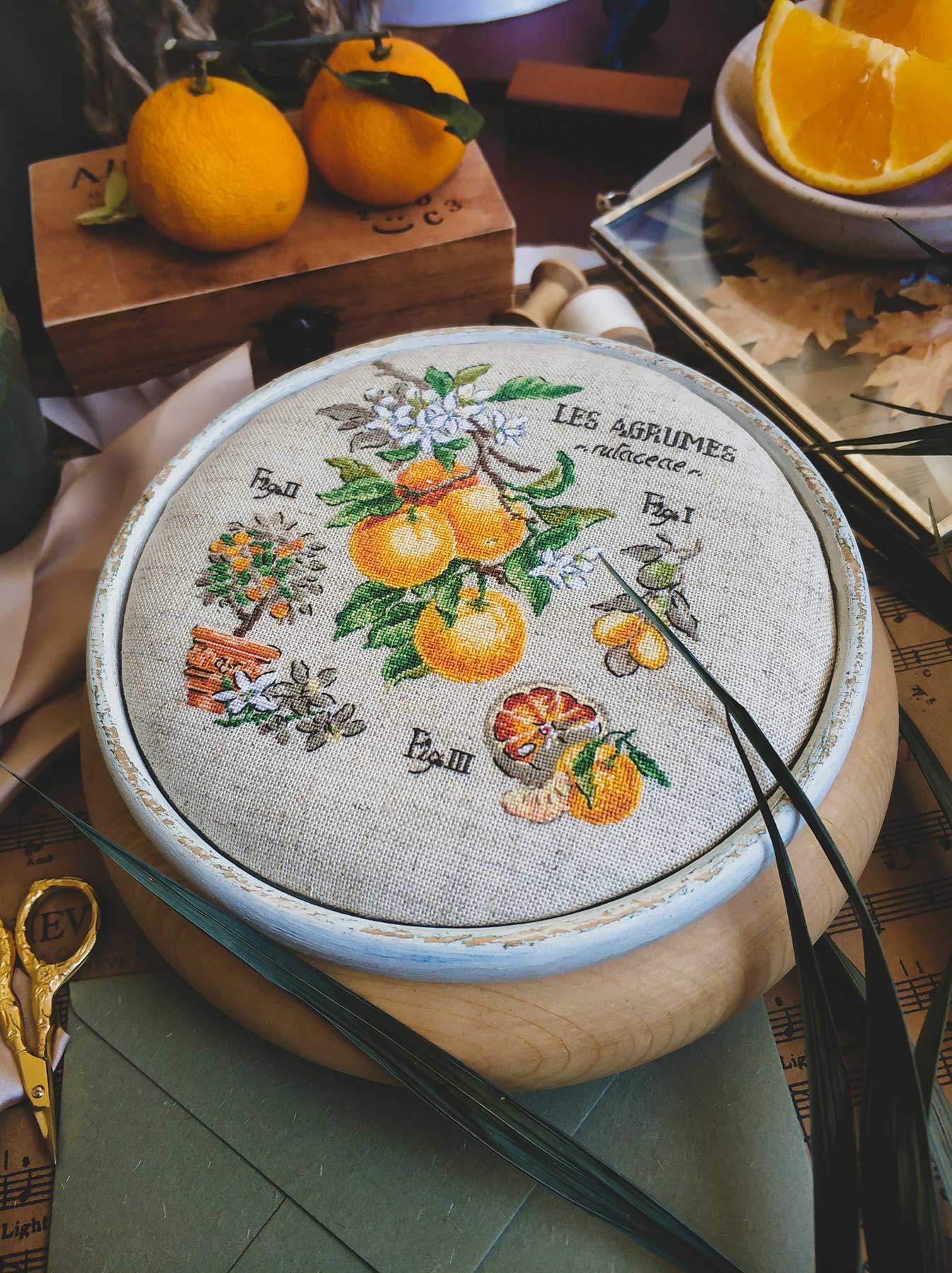
Here are the dictionary definitions of "weave" and "weaving":
Weave:
1. To form (fabric or a fabric item) by interlacing long threads passing in one direction with others at a right angle to them.
2. To make (a complex story or pattern) from a number of interconnected elements.
Weaving:
1. The craft or action of forming fabric by interlacing threads.
2. The act or process of combining different elements to form a cohesive whole.
The word "weave" invites artists to approach their craft with patience, interconnectedness, and respect for tradition. Whether literally working with fibers or translating this concept into other media, weaving can inspire artists to:
• Slow down and appreciate the process as a journey in itself.
• Embrace the layered, complex nature of creativity, allowing ideas and emotions to interlace naturally.
• Draw on personal and collective stories, reflecting on how every thread contributes to the larger tapestry of life and art.
This month, let weaving be a reminder that art, like winter, thrives in quiet reflection and thoughtful connections. Each thread, each idea, and each element adds to a greater whole, creating work that is rich in texture, meaning, and warmth.
Let’s tap into our creative intuition and do some self-reflective work inspired by our theme. Below you will see our month’s Oracle/Tarot card spread. But fear not, if you are not one drawn to using oracle or tarot cards, no worries, just use the accompanying reflective questions as writing prompts for your journals!
Three-Card Spread: "Threads of Reflection"
Card 1: "The Thread" (What you bring into this season)
Purpose: This card represents the energy, skills, or experiences you are carrying with you into this time of wintering and stillness. It could reveal a strength, a lesson learned, or a resource that will support you in this season.
Reflection Prompt: What unique thread am I weaving into this season? How can I nurture this aspect of myself as I slow down and reflect?
Card 2: "The Loom" (How to embrace stillness and mindfulness)
Purpose: This card represents the structure or practice that will help you find peace and mindfulness. It invites you to consider how you can create a “loom” in your life—whether a daily ritual, creative practice, or mindset—that supports inner stillness.
Reflection Prompt: What practices or routines will ground me in the present? How can I weave stillness and intention into my daily life?
Card 3: "The Tapestry" (The bigger picture)
Purpose: This card reveals what you are working toward, the larger “tapestry” you are contributing to with each thought, action, and creative endeavor. It’s a reminder of the beauty and meaning in each small act of creation.
Reflection Prompt: How does my creativity connect to the larger tapestry of my life? What themes, stories, or values am I weaving into my world?
This spread encourages a deep, reflective journey into your own creative and personal intentions, helping you embrace the beauty of weaving your life and art with mindfulness and purpose.
Set the Mood:
Focus Your Intention:
Shuffle the Cards:
Draw the Cards:
Reflect on Each Card:

Treat yourself to this wonderfully soothing winter themed meditation from one of my favorite meditation creators - Rachel Hillary
Here’s a little more information from Rachel…
This is a guided journey I have crafted, to deliver you into the magic of your own being. We will dwell between the lightness and the dark, and watch as the shadows cast magical spells. This adventure begins on the beach by dark, during the middle of a thunderstorm. You take shelter in a candlelit cave nearby, and a beautiful, subtle process of spiritual germination unfolds. We acknowledge the majesty of the shadows, and welcome in the sweetness of the new light.
lots of love,
Rachel
Each month we will have a positive affirmation. I recommend you print out this affirmation and put it in your sketchbook or somewhere in your studio. Recite the affirmation out loud each time you show up to create. Saying words aloud is powerful and can begin to re-write some of our own limiting beliefs or calm our fears. Try it now…
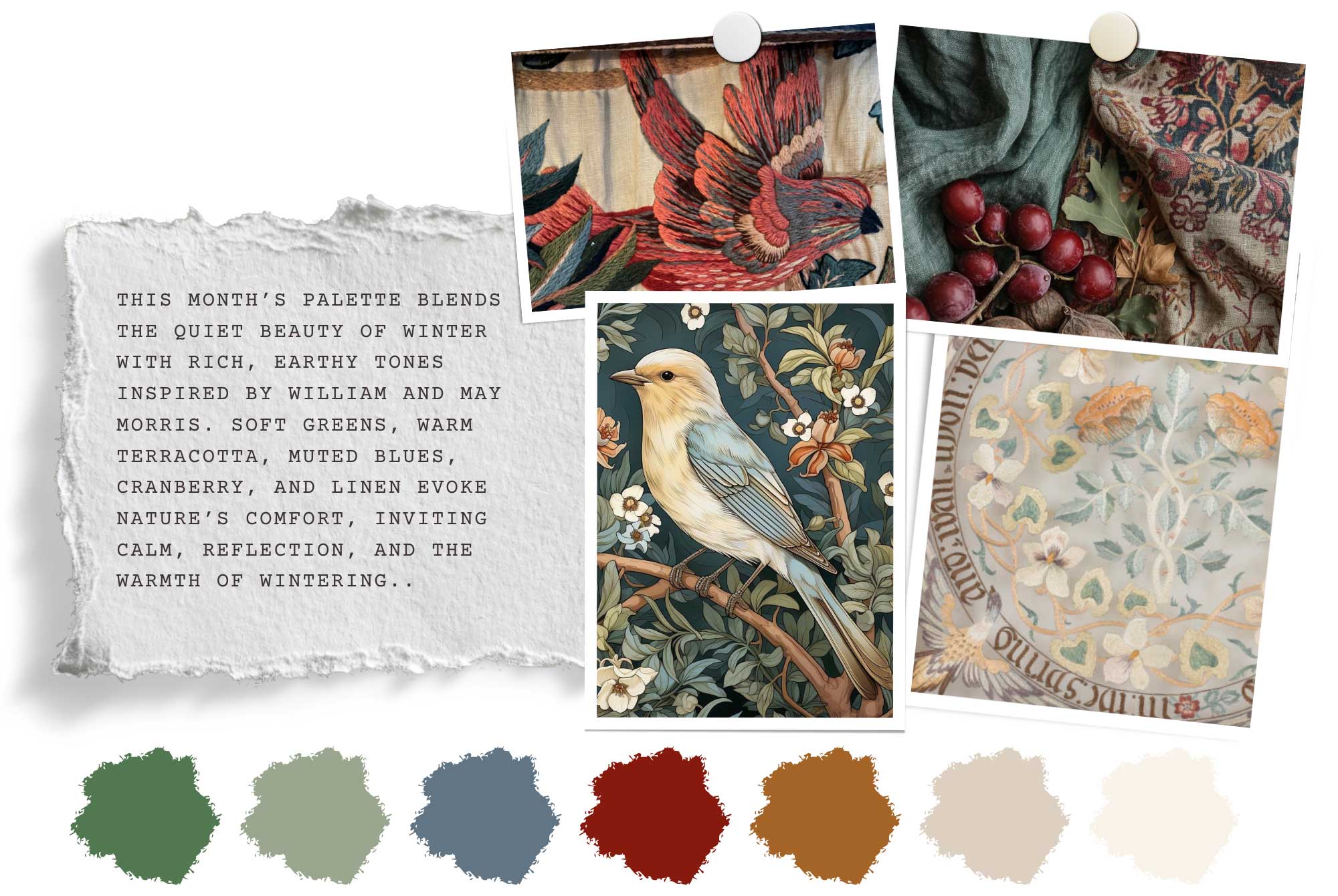
This month’s color palette blends the quiet beauty of winter with the rich, earthy tones of textile art. Inspired by William and May Morris, these soft greens, warm terracottas, and muted blues evoke the grounding comfort of nature, while deep cranberry and linen bring a touch of warmth and purity. Together, they invite a sense of calm, reflection, and the nurturing embrace of wintering.
Soft Sage Green – Inspired by nature and plant life, this muted green brings a sense of calm and grounding, like evergreen foliage in winter.
Warm Terracotta – Reflecting the earthy tones of textiles and clay, terracotta adds warmth and coziness, perfect for creating a nurturing, home-like feeling.
Dusty Blue-Grey – A cool, restful blue with a hint of grey, this color evokes the quiet stillness of a winter sky or shadowed landscape, balancing the palette with serenity.
Deep Maroon or Cranberry Red – Inspired by rich floral hues in Morris’ patterns, this shade brings depth and a gentle vibrancy, symbolizing passion and warmth amid winter.
Cream or Soft Linen – A soft, natural off-white reminiscent of fabric and wool, this color symbolizes purity and simplicity, tying the palette together with an airy, light touch.
This month, we’re honored to explore the timeless artistry of William Morris and his daughter, May Morris—pioneers of the Arts and Crafts Movement, whose textile creations are woven with beauty, nature, and intentionality. Their work celebrates the slow, meditative process of handcraft, embodying our themes of wintering and stillness. Through their intricate patterns and rich textures, William and May invite us to embrace warmth, creativity, and a deep connection to the natural world, offering inspiration to weave these same qualities into our own art this season.
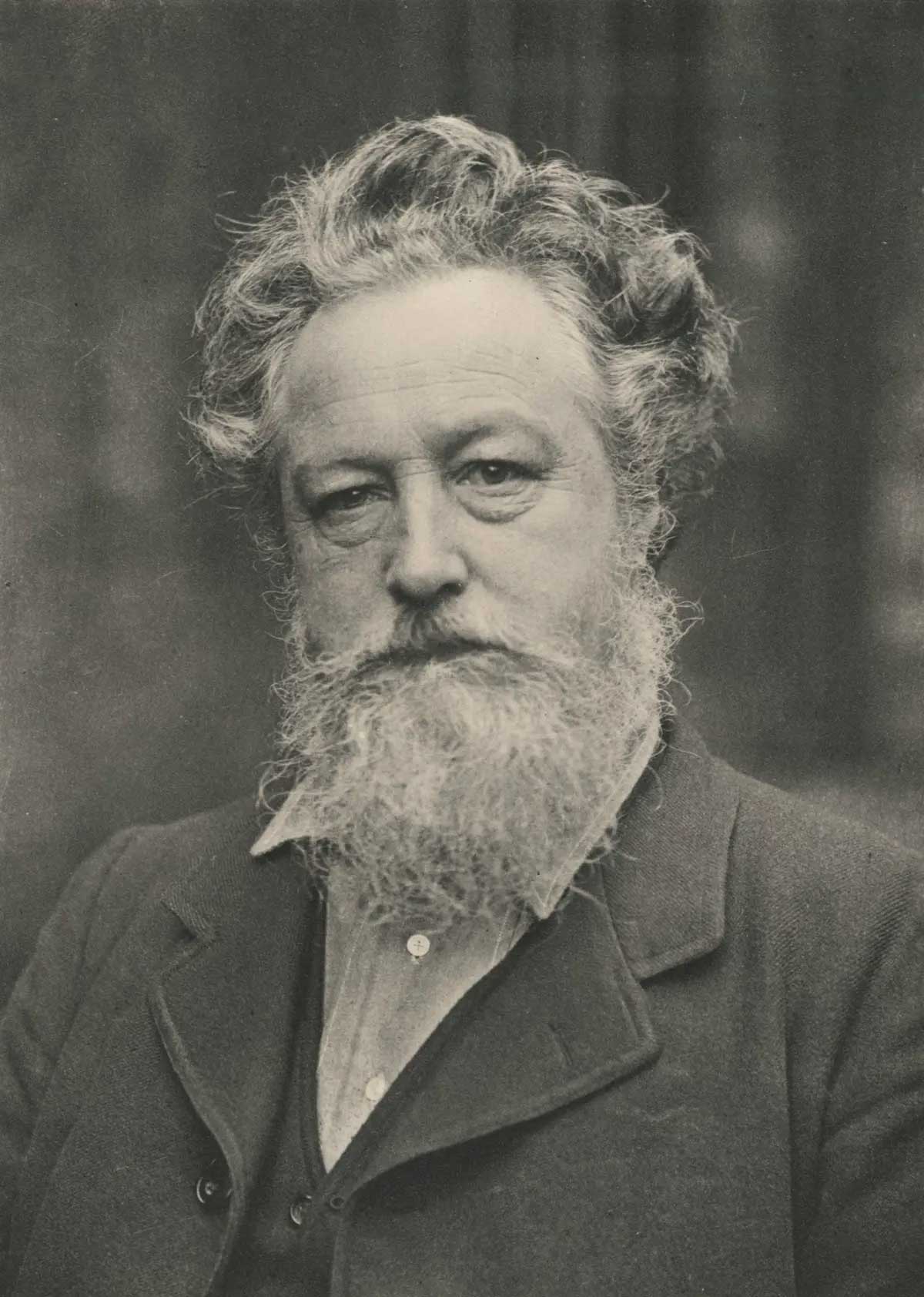
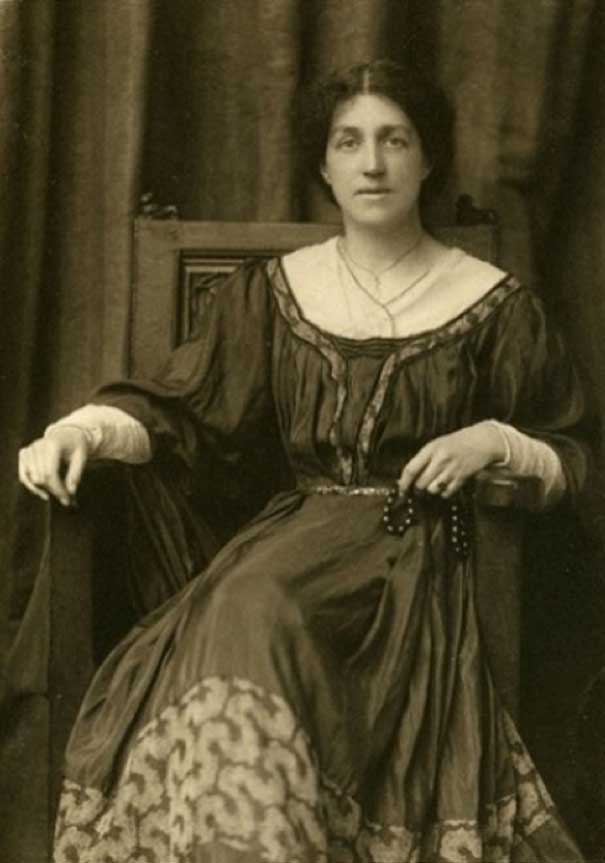
William Morris (1834–1896) and his daughter May Morris (1862–1938) are pivotal figures in the history of textile art, known for their role in founding and shaping the Arts and Crafts Movement. This movement championed the beauty of handcraft and a return to the slow, deliberate processes of creating art, particularly in response to the mass production of the Industrial Revolution. Both father and daughter left an indelible mark on textile design, and their legacy resonates deeply with the themes of wintering and stillness, as their work encourages us to embrace quiet, thoughtful creation.
William Morris was an influential British designer, poet, writer, and social activist. He founded the Arts and Crafts Movement in the late 19th century, advocating for a return to traditional craftsmanship and an appreciation for the beauty of hand-made goods. At the time, the Industrial Revolution had introduced mass-produced items, which Morris believed lacked the soul and artistry that came from handcrafted work.
Morris' philosophy was simple: art and everyday life should be intertwined. He believed that the things people lived with, whether they were household textiles or architectural designs, should be made with care, beauty, and intentionality. Morris designed intricate wallpaper patterns, tapestries, and textiles that celebrated nature, incorporating swirling leaves, flowers, and birds in a style that was both timeless and deeply connected to the natural world.
His work represented a form of resistance against the industrialization that had overtaken creative labor. In Morris' view, art should be restorative—both for the creator and the viewer—offering beauty, warmth, and a sense of stillness in an increasingly fast-paced world. His designs brought nature indoors, especially during the winter months, when cold and darkness might otherwise make homes feel barren. The comforting and enveloping designs created a sense of connection to nature and warmth, even when the world outside was dormant.
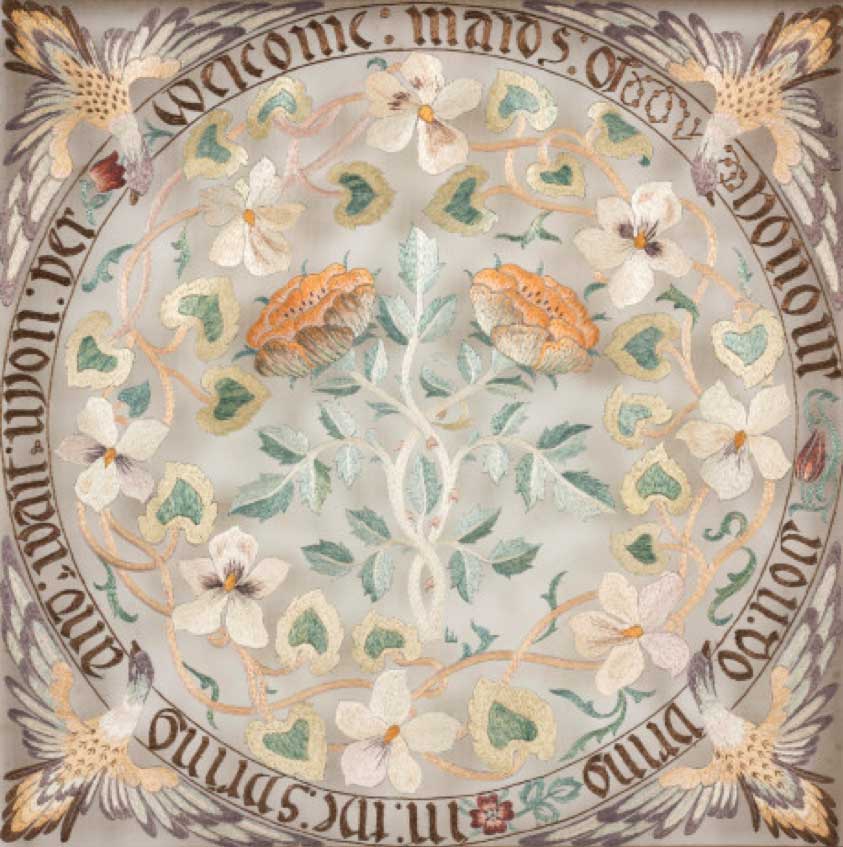
Maids of Honour panel, designed and embroidered
By May Morris, floss silk on silk net
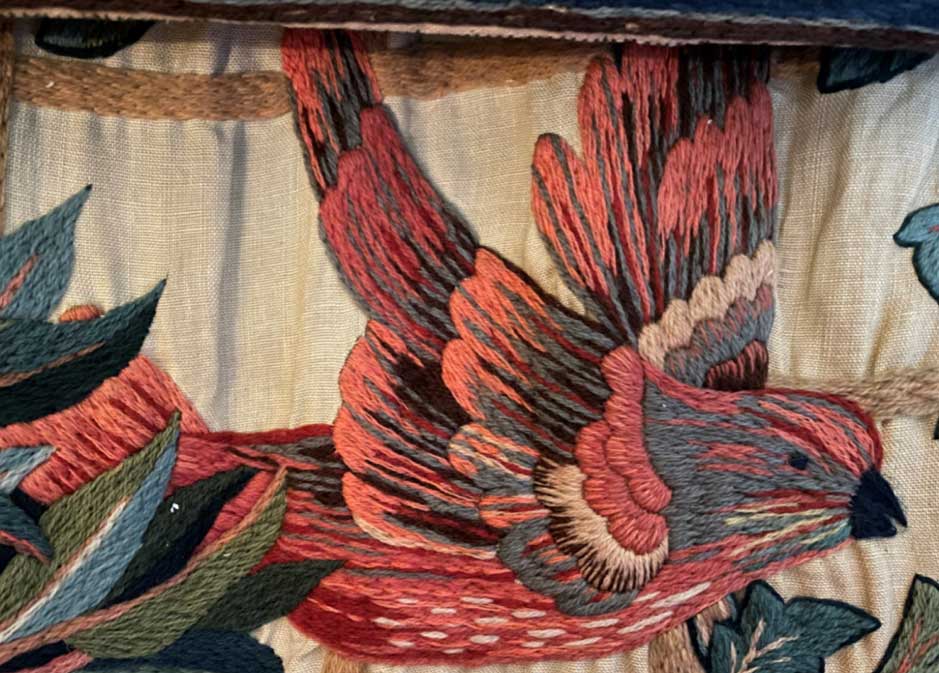
Detail of the Kelmscott Hangings
By May Morris
While William Morris was the public face of the movement, it was his daughter, May Morris, who brought much of the artistic vision to life, particularly in the realm of textile arts. May Morris was a master embroiderer, designer, and teacher. She took over the embroidery department of Morris & Co. at just 23 years old, continuing to shape the aesthetic of the Arts and Crafts Movement while championing the role of women in the arts.
May's work in embroidery exemplified the meditative and reflective nature of textile art. In embroidery, each stitch is deliberate, repetitive, and calming—requiring focus and patience. It is a slow art form that rewards careful attention, much like the process of wintering. The act of stitching, like wintering, is a way to slow down, to reflect, and to create warmth both physically and emotionally.
May’s designs, like her father's, were often inspired by nature. She created intricate floral patterns and designs filled with birds and organic motifs, connecting the indoors to the natural world outside. Her work embodied the ideals of the Arts and Crafts Movement by using natural materials and handcrafting techniques, bringing a sense of warmth and comfort to the home.

In both William and May Morris’ work, we see a strong connection to the theme of wintering—the practice of slowing down, reflecting, and embracing stillness during the colder, darker months. Textile art, particularly in the hands of the Morrises, is a perfect medium for this theme. The act of creating textiles—whether through weaving, embroidery, or tapestry—is inherently slow, requiring repetition, patience, and focus. This makes it a meditative practice, offering the artist a chance to turn inward, much like the natural world does during winter.
For William Morris, the designs he created for homes were meant to evoke a sense of comfort and beauty, making even the coldest winter months feel alive with warmth. His intricate patterns, often inspired by leaves, flowers, and natural forms, offered a reminder of nature’s resilience even in times of stillness. These designs allowed homes to become sanctuaries, filled with visual reminders of the cycles of life and nature, creating spaces where stillness could be embraced and savored.
For May Morris, the act of embroidery was a form of creative wintering. Each stitch, each thread was a testament to the power of slow, deliberate creation. Her work was not just about decoration—it was about the mindful process of creating something with intention and care. The repetitive motions of embroidery mimic the rhythms of wintering: slow, deliberate, and purposeful. Her use of natural themes in her embroidery—flowers, leaves, and organic shapes—reminds us that even in times of stillness, life and beauty continue.
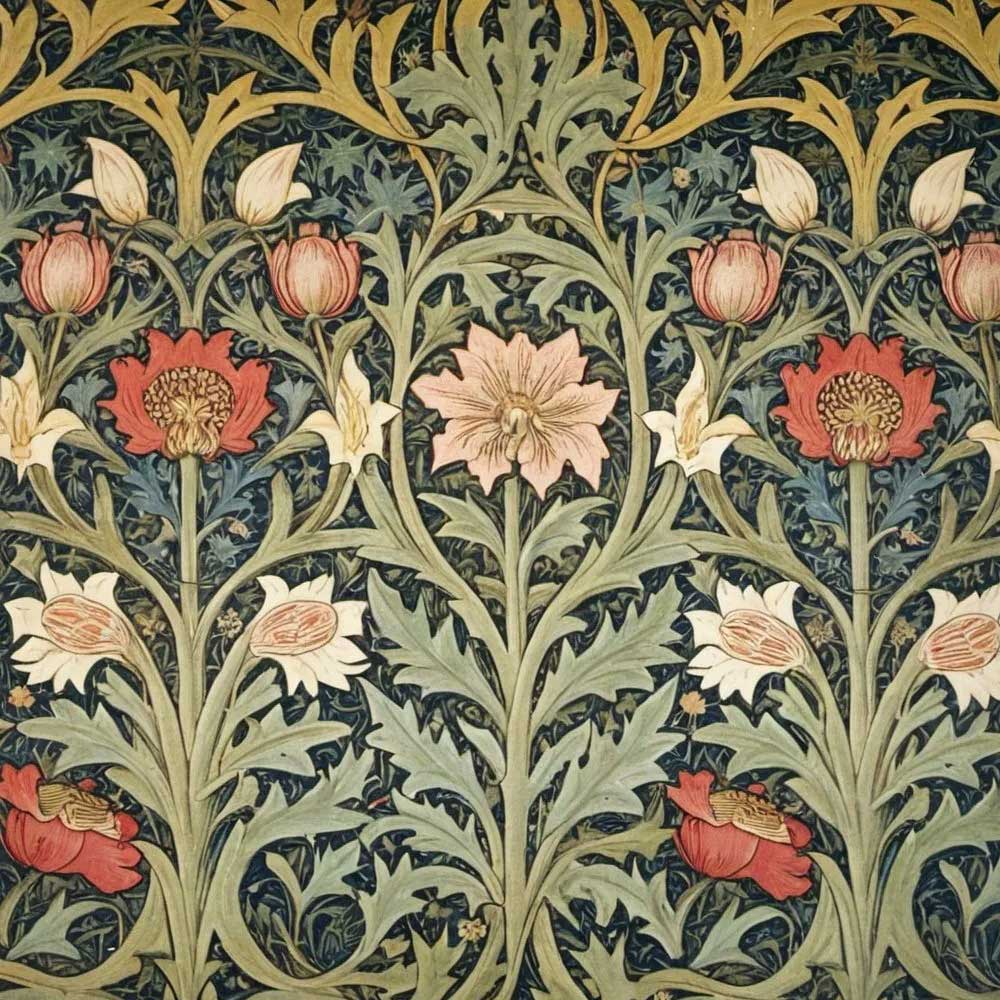
In the context of "wintering" and stillness, the Morrises’ work in textile arts offers inspiration for artists and creators today. As the colder months encourage us to turn inward, the slow art of textile creation becomes a way to embrace stillness, to create warmth, and to reflect on the beauty of nature even when it is in hibernation. The careful, repetitive motions involved in embroidery, weaving, or quilting offer a sense of calm and grounding, allowing the maker to reconnect with the present moment.
The legacy of William and May Morris continues to remind us that art is not just something we observe—it is something we live with. In their hands, textile art became a means of bringing warmth and beauty into the home, offering a way to reflect on the cycles of nature and the slow rhythms of life. As we winter and slow down, their work invites us to engage with our craft in a more mindful, intentional way, creating spaces of warmth and stillness in both our art and our lives.
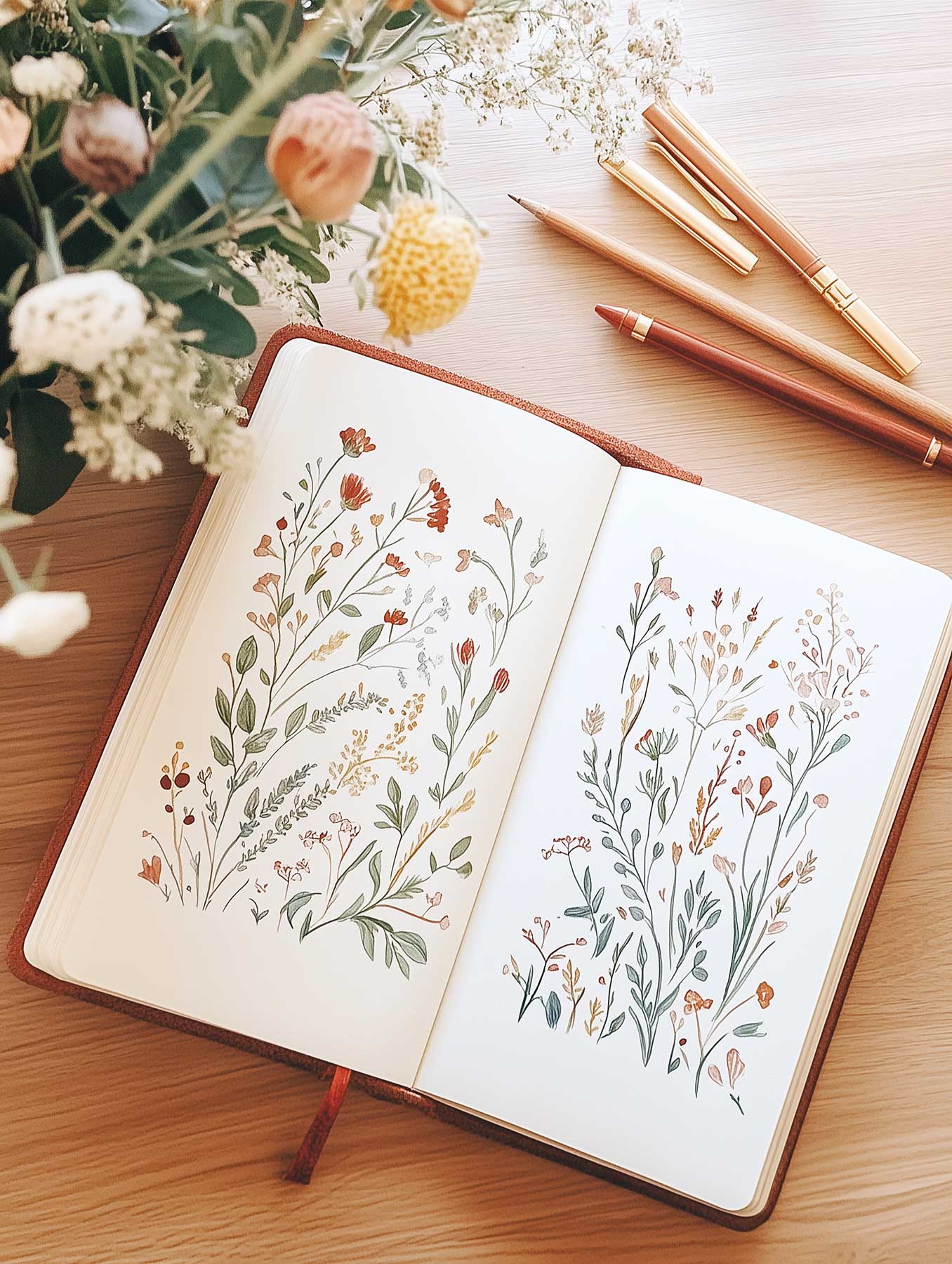
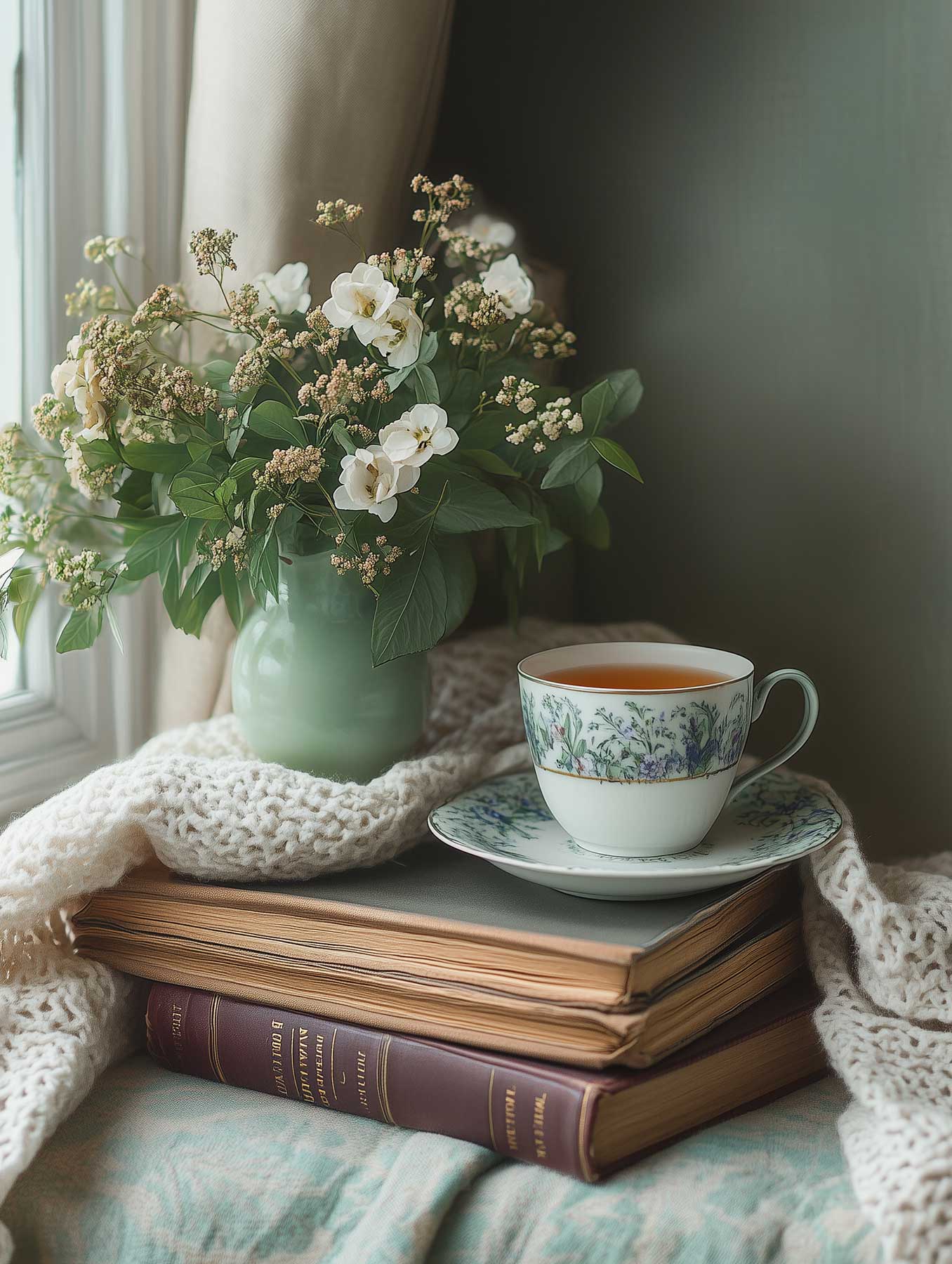
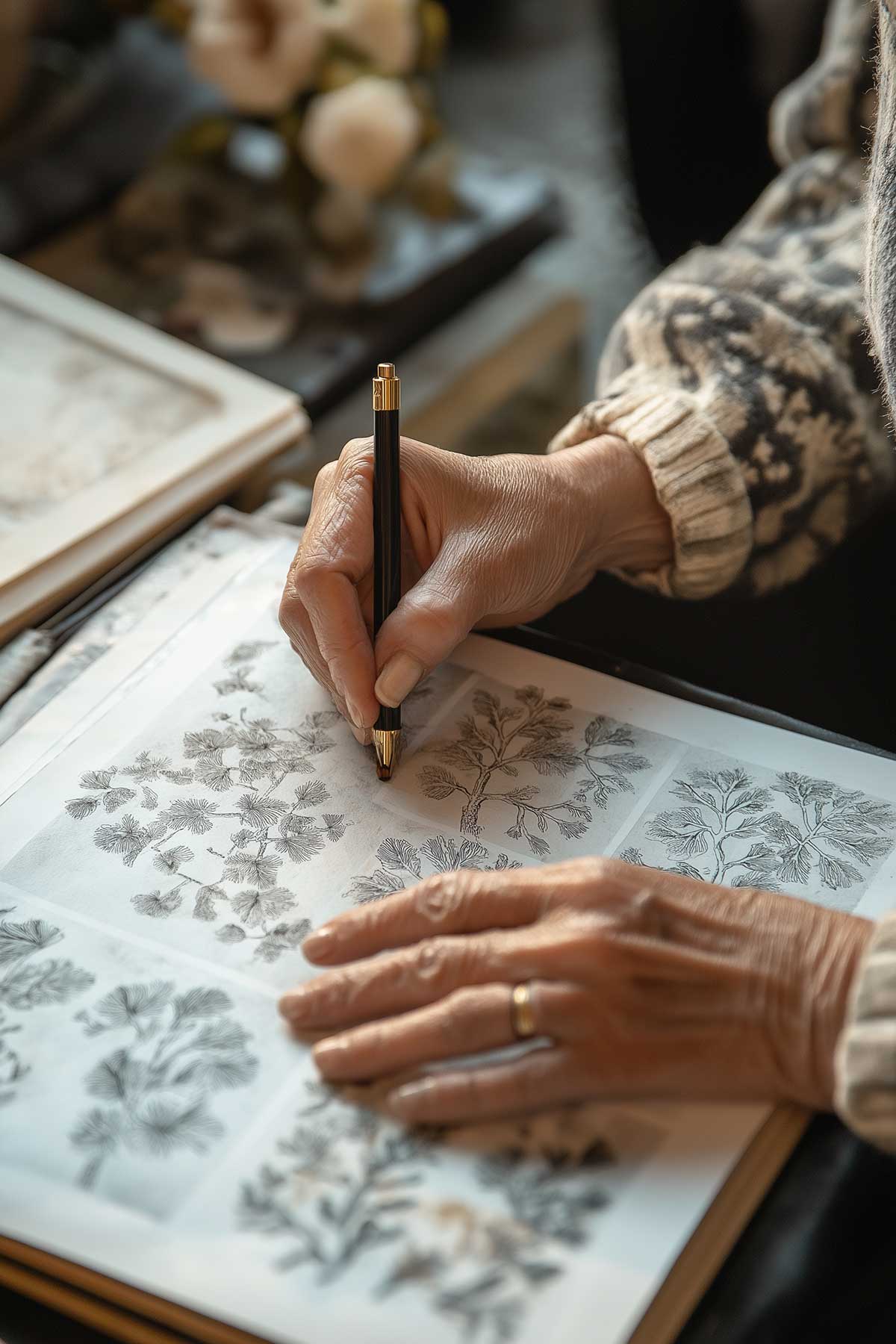
This month, I thought Jeanne-Marie Webb's wonderful class, Painting with Threads, fit perfectly with our Studioworks Journal.
This class is rooted in nostalgia, discovery, and a deepening of creative expression—a continuation of playful exploration I’m excited to share with you. Here, we’ll embrace an untraditional approach to stitching that leaves all the rules behind.
With no set patterns, we’ll savor the beauty of texture, color, and the peaceful rhythm of each stitch, letting this meditative process bring calm and joy to our souls. Enjoy!
You can also listen to this month’s issue of the Studioworks journal. I find I love listening to books, podcasts and music while I draw, paint or go on a long walk. Enjoy.


One of my favorite things to do is to curate inspiration. From Pinterest boards to books, resources, playlists and more - I love to share anything that might facilitate learning, expansion, and sparks of curiosity! Being an artist, we naturally crave these things so here are some of this month’s picks from me to you.
I had so much fun curating this list. I hope you enjoy!!
Here are just a few of our fantastic classes! I highly recommend checking them out if you haven’t already. Enjoy!